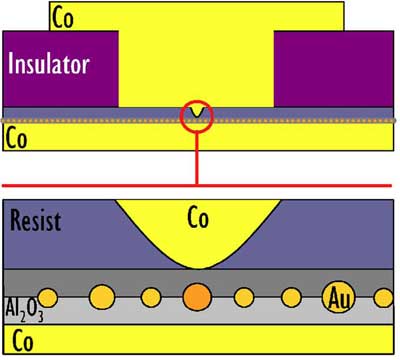| Posted: Oct 04, 2006 | |
A tabletop technique to probe the spin dependent transport in single nanosized objects |
|
| (Nanowerk Spotlight) Spintronics (short for "spin-based electronics") is an emergent technology which exploits the quantum propensity of electrons to spin as well as making use of their charge state. The field of spintronics got started in 1988 with the discovery ("Giant Magnetoresistance of (001)Fe/(001)Cr Magnetic Superlattices") of giant magnetoresistance effect in magnetic multilayers in which a single dimension was reduced to the nanometer range. The field was then extended to structures with two reduced dimensions like nanowires and nanopillars or nanotubes. Today, a challenge for spintronics is the study of spin transport properties in structures based on zero-dimensional elements in which the three dimensions have been reduced. So far, very few techniques allow to contact a single isolated nanometer sized object to study the effect of confinement on spin transport. Researchers in France now describe the experimental achievement of a technique that allows to inject and detect spins in a single isolated nanometer-sized cluster. They fabricated nanometer-sized magnetic tunnel junctions using a conductive tip nanoindentation technique in order to study the transport properties of a single metallic nanoparticle. | |
| "We have developed an original process to investigate the spin transport properties of a single nanoparticle and provided evidence for its successful realization, "Dr. Pierre Seneor, assistant professor in the Unité Mixte de Physique laboratory at the University of Paris Sud, summarizes the findings for Nanowerk. "Our approach paves the way for a more in-depth study of magneto-Coulomb phenomena in nanosized clusters." | |
| Seneor is co-author of a recent paper titled "Evidence for spin injection in a single metallic nanoparticle: A step towards nanospintronics" that was published in the August 7, 2006 issue of Applied Physics Letters. Two of the authors of the paper, Albert Fert and Frédéric Petroff, were part of the team that wrote the 1988 paper mentioned above. | |
| "It is a real challenge to connect a single isolated 0D nanometer sized object to ferromagnetics leads for transport measurements" Seneor says. "Until now, only one result had been put forward ("The Kondo Effect in the Presence of Ferromagnetism"). Here we demonstrate a new method to connect such a small object to ferromagnetic leads without requiring high cost state of the art nanostructuration techniques." | |
| While only two results are available up to now on connecting a 0D nano-object to ferromagnetic electrodes enabling spin polarized injection and detection, extensive theoretical studies have been undertaken, leaving the field wide open for experiments. | |
| To define an electrical contact on a single gold nanocluster the group used a four step process combining atomic force microscopy (AFM) and optical lithographic techniques. The resulting structure consists of a Co/Al2O3 bilayer with gold nanoclusters embedded in the thin alumina layer. This structure allows the tunneling of electrons into and out of a single gold nanoparticle. | |
 |
Schematic cross section of the whole patterned structure showing the top/bottom Co electrodes and the 2D assembly of nanoparticles embedded in a thin alumina layer. The circle represents the zone zoomed in the bottom drawing. (Reprinted with permission from The American Institute of Physics) |
| The method used by the French scientists is straightforward and versatile enough to enable the separate choice of barriers materials and ferromagnets and their thickness while preserving high yield. Beside a standard clean room for the main structuration, the only requirement is a conductive tip module (commercially available) to be added to the AFM available in most of the microelectronics laboratories. | |
| "One of the things we would like to do is to add a gate to our system" says Seneor. "We are working on this right now. We have some ideas to work it out without adding too much complexity to our process. We hope we will have more to say any time soon?" | |
| He concludes: "Successful spin manipulation in quantum dots connected to ferromagnetic leads is maybe one of the most thrilling directions of this field." | |
 By
Michael
Berger
– Michael is author of three books by the Royal Society of Chemistry:
Nano-Society: Pushing the Boundaries of Technology,
Nanotechnology: The Future is Tiny, and
Nanoengineering: The Skills and Tools Making Technology Invisible
Copyright ©
Nanowerk LLC
By
Michael
Berger
– Michael is author of three books by the Royal Society of Chemistry:
Nano-Society: Pushing the Boundaries of Technology,
Nanotechnology: The Future is Tiny, and
Nanoengineering: The Skills and Tools Making Technology Invisible
Copyright ©
Nanowerk LLC
|
Become a Spotlight guest author! Join our large and growing group of guest contributors. Have you just published a scientific paper or have other exciting developments to share with the nanotechnology community? Here is how to publish on nanowerk.com.
